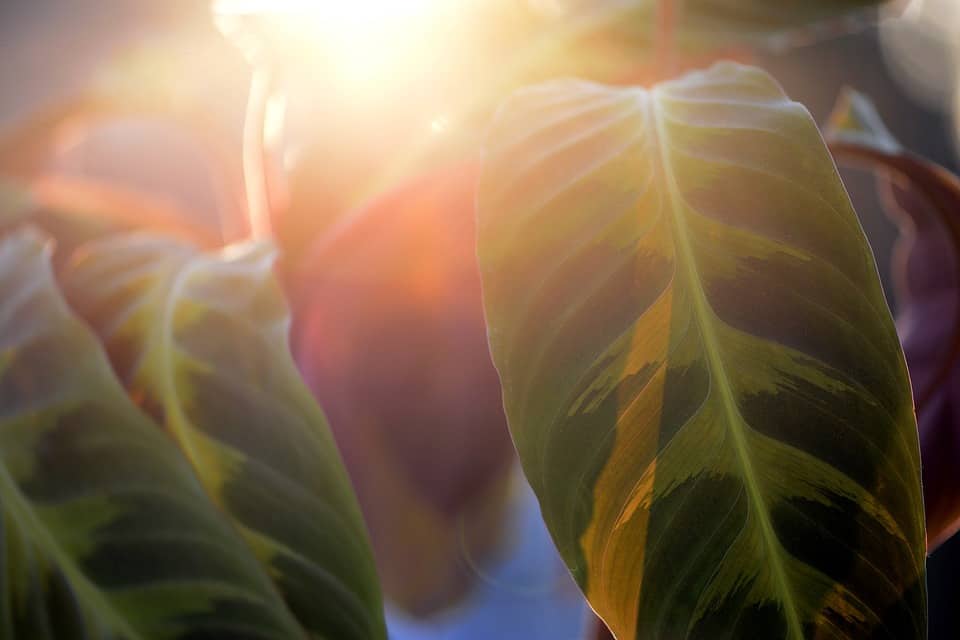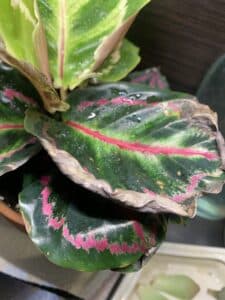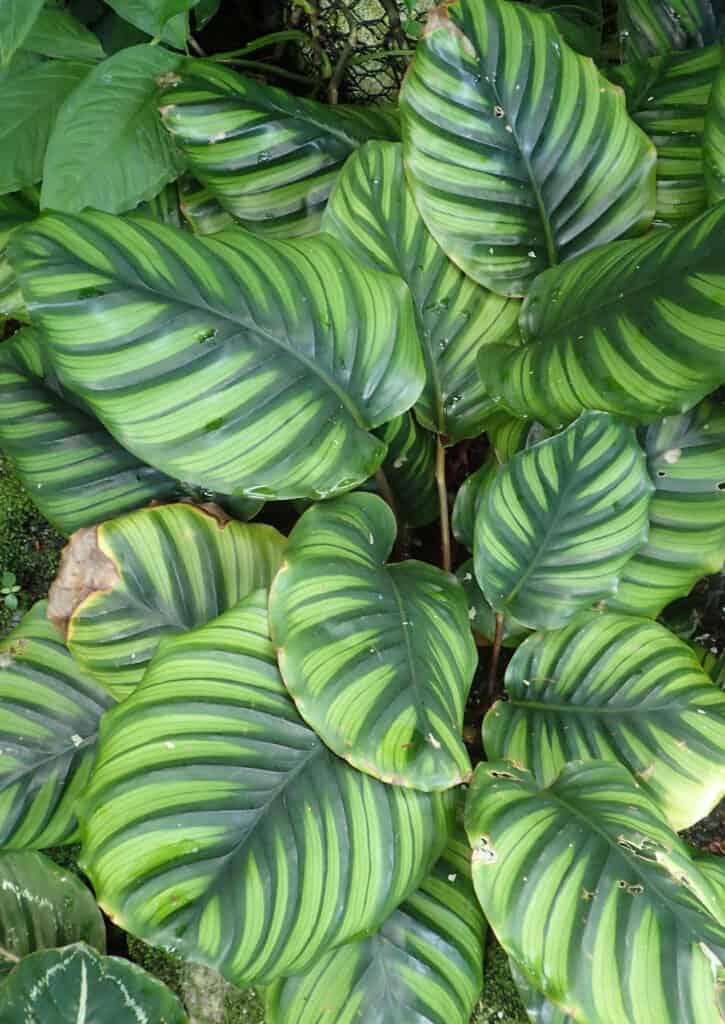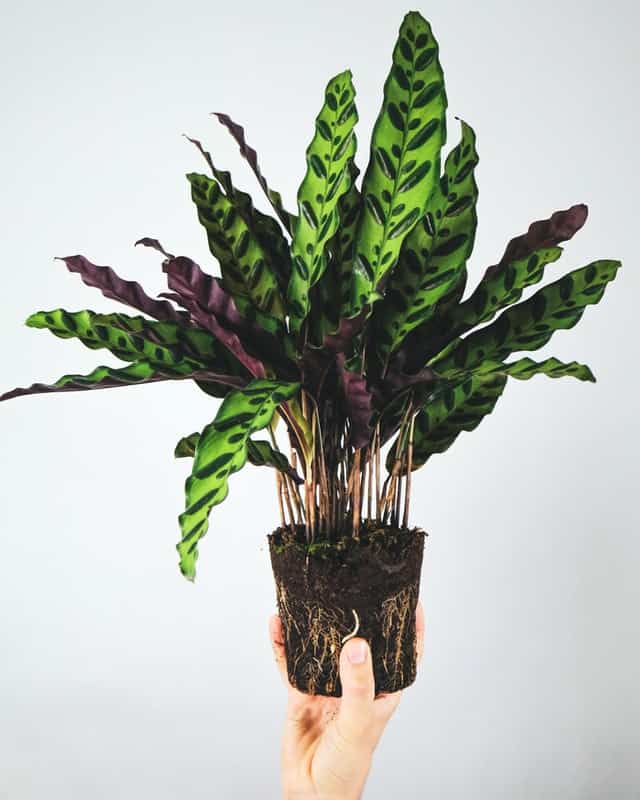The calathea plant is an incredibly stunning houseplant, one of my favorites for home decor.
The intricately detailed patterns on their foliage truly make them stand out.
Moreover, they close their leaves during nighttime and open them up during the day. Interesting, aren’t they?
After looking at the plant, one thought might be lingering in your mind; these plants are captivating to look at, so they must be difficult to care for.
Some common calathea plant problems are leaves turning yellow, edges of leaves turning brown and brittle, curling leaves, root rot, limp and floppy plant, and stunted growth. Pests, including spider mites and mealybugs, are also common. In addition, Grey mold and Bacterial Leaf Spots are two prevalent diseases in Calathea.

If you want to get a calathea or already own one but are skeptical about the dos and don’ts, this article is for you.
We will discuss all the possible problems, their causes, and solutions. So stay tuned to learn more about these plants.
Table of Contents Show
13 Common Calathea Plant Problems and Their Solutions
These are some of the most common issues faced in a calathea plant.
If you face any problem with your plant, you might find the perfect solution here!
1. Leaves Turning Yellow
Yellowing and browning are both indicators of overwatering and underwatering in calathea.
The yellowing of the plant’s core is considered more dangerous than external discoloration.
The plant requires relatively constant, slightly damp soil, but if you place it in very soggy soil, its leaves become yellow, and its roots may also be threatened.
In addition, the plant will reabsorb nutrients from the lower leaves as it grows, making them yellow and brown before falling.
Again, this is natural, so if it’s just the lowest leaves that are yellowing, you’ll be alright.
Solutions
- Water once a week; check if the soil is dried out halfway down between waterings.
- Watering must be done more often in better light and less frequently in lower light.
- For optimal growth, it needs at least 8-10 hours of bright, indirect light.
- Give your plant a few weeks to recover if you have shifted it to a new place or repotted it.
- Over-fertilizing can be remedied by flushing the soil with distilled water.

2. Edges of Calathea Leaves Turning Brown and Brittle
It is typically an indication that the air in the room where your plant is located is excessively dry.
When it comes to houseplant problems, always assume bugs can also be blamed.
Exposure to low temperatures and strong winds may also cause the leaves to turn brown and brittle.
Pests can cause your Calathes’ leaves to become brown as they seek to destroy them and drain the nutrients.
Salts, chlorine, minerals, and fluoride are all found in tap water, so excessive watering with it can cause build-up in your plant’s soil, causing the edges of the leaves to turn brown and curl up.

Solutions
- Calathea prefers a humidity level of 50 percent or more, so you can use a humidifier if needed.
- If you think overfeeding is the problem, cleanse the soil by letting some water run through it for a few minutes.
- Move it to a location where it won’t be exposed to temperatures below 55°F.
- Use pots with drainage holes to prevent overwatering.
- If you observe movement, webs, little dark spots on your plant, you should treat it for pests.
- You can trim off severely damaged parts of your Calathea.
- It is best to use distilled water but, rainwater and filtered water also work well.
- Flush soil with distilled water to remove the excessive salt build-up.
3. Browning Tips on Leaves with Yellow Halo
The browning of leaf tips on older foliage is completely normal and results from tremendous photosynthesis throughout the leaf’s life.
Calathea thrives in strong, indirect light, and harsh rays from direct sunlight for a prolonged time causes indications of sunburn and shock.
This is seen in the form of browning or yellowing of the plant.
If your plant is kept near space heaters or any other heating source, it might cause the leaves’ tips to brown.
Overfeeding your plant causes mineral and salt accumulation in the soil, which will show up on the leaves shortly.
Solutions
- Keeping them together can help boost local humidity but don’t cram them too close.
- Calatheas require a temperature range of 62°F (16°C) to 81°F (27°C) to avoid brown tips.
- A balanced indoor plant fertilizer with a 10-10-10 NPK ratio (nitrogen, phosphorus, potassium) is recommended to apply during its growing period.
- Avoid overhead watering, keep the leaves dry. A moist environment aids the growth and multiplication of infections.

Here’s an Amazon link for Indoor plant fertilizers.
4. Leaves Curling
Calathea leaf curling indicates underwatering, which results in a protective mechanism used by the plant to prevent water loss.
On the other hand, too much water might cause roots to rot, resulting in curled leaves.
A healthy Calathea turns its leaves gently to collect ambient sunlight, whereas a sick Calathea curls its leaves firmly to indicate concern.
Too much sunlight and temperature extremities may cause its leaves to curl.
Low humidity is another prevalent reason that causes your calathea leaves to curl up.
These plants collect moisture through their broad leaves, which curl and yellow if the air becomes too dry.
There may be a harsh or brittle feel to the leaves, and the margins of the leaves may split when stroked.
An excess of minerals in the water supply is also another typical cause of unhealthy and curled Calatheas.

Solutions
- Do not put your plant in the way of heating and cooling vents or a drafty region.
- Calatheas despise direct sunlight so place them in enough ambient light to absorb.
- Use a humidifier to increase humidity levels.
- If you keep them in low-humidity levels, misting can also help to combat drying.
- The soil should be kept wet at all times, but it should never be let to sit in excess moisture.
- Give small amounts of water consistently to find the proper balance.
- To avoid startling the plant, keep the water at normal temperature.
After trying these suggestions, remove any irreversibly damaged leaves with gentle pruning.
5. The Pattern in Leaves Fading
Calatheas are known for their beautiful leaves, so it’s a bummer if the patterns start to disappear.
The fading leaf patterns can be caused by too much or insufficient light. However, too much direct sunshine is most likely to blame.
When calathea leaves receive full sunshine, the chlorophyll takes control, and the distinctively dark and light patterns on the leaves soften and fade.
Eventually, the leaves may develop burn spots. The plant may be struggling due to a lack of nutrients as well.

Solutions
- Relocate your calathea to a spot with more shade or indirect light to restore the pattern.
- Chose a spot with ambient sunlight; a north-facing window can help.
- Once a month, use a diluted regular houseplant fertilizer.
- It would be best to keep in mind that they should not be kept in a very dark room.
6. A Limp and Droopy Calathea
When a calathea plant leaves wilt or droop, it’s usually because it’s thirsty.
However, because the leaves of calathea move up and down in response to light, make sure that you’re not mistaking natural movement for a need for water.
Calathea may also limp and droop due to overwatering and colder temperatures.
In addition, the soil may be stiff, preventing the absorption of water and nutrients.
During the day, you may observe that the leaves of your plant droop more.
This is entirely natural since the leaves fold up at night and unfurl throughout the day.
If the drooping is severe, there might be a more serious problem.
Drooping calathea leaves have similar reasons to curling of the leaves.
Solutions
- Move your Calathea to a warmer place, away from other sources of unexpected temperature swings.
- Ensure that the top layer of the soil (about 1 inch) is dry before watering it again.
- Its location must be out of any strong winds from doors or windows.
- Aerate the soil to ensure that the water reaches the roots.
- If the soil is damp, you’ll either have to go waterless or relocate the plant to a brighter spot.
7. Root Rot in Calathea
Root rot is a typical problem with specimens sitting in overly wet or saturated soil for an extended period.
Common symptoms are rapidly withering leaves, reduced development, and a decaying brown base.
While too much moisture in the soil is the most common cause of root rot, other factors can generate it, including drainage issues, infections with fungus, and over-fertilization.
Moreover, Cercospora, Bipolaris, and Botrytis are some of the fungi that can cause root rot in your Calathea.
The drainage hole at the bottom of the container is the most crucial feature needed to grow this plant.
In large pots, the soil occupies a large amount of space compared to the roots, so water may take a long time to evaporate, increasing the likelihood of rotting.
Solutions
- Remove your calathea for a closer look, then clip away any dead brown roots.
- Containers with multiple 1/4-inches to 1/2-inches diameter drainage holes are recommended for your Calathea.
- Since soil does not always dry up at the same rate, make a habit of monitoring the soil before watering.
- Use a proper potting mix with a high proportion of chunky components that increase aeration.
- Plant your calathea in a pot with drainage holes and periodically check if the holes are blocked or not.
- If the roots are rotting, stop watering the plant immediately until they revive.
- It is recommended to repot your plant once every 2-3 years.
- After repotting, skip feeding your plant for eight weeks to enable the root system to grow.
- Add hydrogen peroxide to your watering can to prevent root rot.

8. No New Growth
The calathea plant may be agitated by both overwatering and underwatering, limiting the growth of its foliage.
Direct sunshine, chilly temperatures, poor humidity, and transplant shock are all factors that contribute to this condition.
Calathea plants, on the other hand, normally only reach a height of around 2 feet and then stop.
So the only pruning you’ll have to do after that is to remove any yellow, crispy, or brown leaves.
The type of calathea plant you have can also determine how fast it will grow.
It’s important to keep the plant’s soil wet but not soggy. Similarly, like other plants, new growth can also stop due to a lack of proper sunlight.
When the roots of your Calathea have grown too large to fit inside their pot, they might get congested and confined, preventing them from getting enough nutrients and water.
Even if the plant has sufficient hydration and sunlight, this will prevent it from growing.
Solutions
- Repot plant when you believe the roots are getting too big for the pot.
- Choose a pot about 20% larger in diameter than the old one, or around 1-2 inches larger.
- You might want to consider getting a humidity tray for it.
- The temperature range of 16°C to 27°C is ideal for these plants.
- For optimal growth, at least 8-10 hours of bright, indirect light.
- Water your plant once a week or water when the top 2 inches of soil feels dry.
- Mist the plant once a week.
- Periodically prune or cut down dead/dying leaves.
- Use a liquid formula with a nitrogen, phosphorus, and potassium ratio that is balanced (NPK).
- A 3:1:2 ratio organic fertilizer can also be effective.

You can find misting spray bottles and pruning shears on Amazon.
9. Dry and Brown Spots on Leaves
Dry and brown spots on your Calathea are most likely due to a lack of humidity in your house or because you watered it excessively with tap water.
If your plant is kept in very bright sunlight for a prolonged time and without proper humidity, soon dry spots will develop on the plant.
Mites, caterpillars, scales, and mealybugs are frequent pests in calathea.
They puncture the tissues and suck the moisture out. Hence, it can also lead to dry and brown lesions or spots.
The leaves become dry and papery as the roots suffocate.
Chlorine and minerals in the water are toxic to many indoor plants. This is also a common cause of brown, papery patches on leaves.
Diseases such as algal leaf spot, anthracnose, and septoria leaf spot can cause brown spots on Calathea leaves.

Solutions
- Spray the leaves of your calathea with a mist once every three days or so to offset the drying effects of air currents.
- Use a humidifier or a humidifying tray.
- Read the label carefully and apply the fertilizer according to the instructions to avoid over-fertilizing.
- Every once in a while, check for fungal growth and apply fungicides as needed.
- Avoid overhead watering; keep the leaves dry as far as possible.
- Limit the amount of time your calathea plant is exposed to direct sunlight to 2 to 6 hours every day. Limit exposure to the bare minimum if the light intensity is too high.
- Use bottled water or rainwater.
- During the night, move your calathea plant to a warmer spot. Temperatures are often lower at night, which might result in frost.
10. Holes on Calathea Leaves
Sun damage and pests infestation are two common causes of holes in Calathea leaves.
If you keep your Calathea under direct sunlight, the leaves will begin to sear, and holes will appear in the foliage.
Pests on the other hand are another cause for Calathea leaf holes.
Caterpillars like to chew holes in leaves, so look in the soil, the undersides of leaves, and the stems to see any hidden caterpillars.
Slugs and snails are notorious for causing holes in leaves, but they’re normally much simpler to notice, and you’d have spotted them by now.
And, we should also be mindful to consider a few natural or cultural techniques before resorting to chemicals.
Solutions
- Locate your plant in a more shady location.
- Check for pests and treat them accordingly as soon as possible.
- If you suspect pests, isolate your plant to prevent the spread of disease to your other houseplants.
- At weekly intervals, spray the plant with a horticultural oil spray.
- A weekly application of diluted neem oil spray.
- Once a week, spray your infected plant with isopropyl alcohol or wipe all over the plant.

11. Falling Leaves
The causes of falling leaves in calathea plants are quite similar to the factors that induce droopy leaves.
Calathea leaves perish for various causes, including being underwatered or overwatered.
Falling leaves might indicate a deficiency in critical minerals that a plant needs to produce strong leaves.
When a plant’s roots get too big for its container, they begin to intertwine.
As a result, the plant suffers from the tangled mass’s inability to obtain water or nutrients in the soil.
But, like any other plant, it becomes stressed when it is repotted addition; the variations in soil consistency and pH can cause the plant to be shocked and induce the falling of leaves.
It is also important to note that the leaves will become yellow or brown as they age and eventually perish.
So, if your plant is old, it might just be natural shedding the leaves to allow new growth.
Solutions
- Make sure the plant is kept in a warm, humid environment and that it is watered regularly.
- A balanced all-purpose balanced fertilizer, such as one with a 10:10:10 nitrogen, phosphorus, and potassium ratio, is suitable.
- Calathea grows well in aerated soil with a pH of 6.5.
- Water it deeply before applying fertilizer to prevent root burn.
- Spring and summer are the best seasons to fertilize calathea for optimal growth.
- Re-pot the plant every 2-3 years and prune damaged or unwanted roots.

12. Pest Infestation in Calathea
If your Calathea leaves have speckled discoloration or are crisping, drying, or browning, you may need to use the magnifying lens.
There’s a potential that the plant is plagued with unwanted guests!
Examine the undersides of the leaves and the points where the leaves meet the stem.
Keep an eye out for little flies as well. The following are some of the most prevalent offenders:
Spider Mites: They have piercing-sucking mouthparts for sucking plant fluids from Calathea leaf. With their white webs that stretch over the stems, they are mostly found on the undersides of the leaves.
Mealybugs: These cottony-looking little beetles prefer to hide in the cracks of leaves and stems, draining the life out of your Calathea.
Fungus Gnats: The adults generate clouds of tiny little pests, but the larvae may eat through your plant’s roots, making these small bugs more of an irritation than anything else.

Solutions
- Treatment for these little pests is spraying the neem oil.
- Instead of dishwashing liquid, use pure, liquid Castile soap with no additives or scents. The fatty acids in castile soap are required to disintegrate the mites’ exoskeletons.
- I recommend introducing beneficial nematodes to the soil to help protect the root structure.
- Use horticulture oil and neem oil to treat pest infestation.
13. Common Diseases
Some common diseases of Calathea are summarized in the table.
| Disease | Symptoms |
|---|---|
| Grey mold | 1. Rotten smell. 2. Black spots with yellow halo. 3. Slimy dark appearance. |
| Alternaria Leaf Spot (Fungal disease) | Yellow, dark brown to black circular leaf spots with concentric rings |
| Fusarium Root Rot | 1. Damping off 2. Decreased root masses with brown discoloration or lesions on roots. |
| Helminthosporium leaf spot | Solid brown topurple lesions or spots to expanded lesions with bleached centers that girdle the leaf blade. |
Solutions
- Remove the infected plant and destroy it.
- Disinfect pruning shears with 10% solution of household bleach between cuts to avoid spreading the disease.
- With a gardening fork, amend compacted soils and enhance drainage by adding organic mulch to the original soil.
- Poorly drained soils exacerbate problems like root and crown rots.
- Avoid overhead watering, which leads to fungal diseases.
- Avoid evening or late afternoon watering to prevent the Helminthosporium leaf spot.
- Use Helminthosporium fungicides regularly.
Note: No chemical treatment is available for Fusarium Root Rot.
Also watch,
Conclusion
Calathea plants are excellent indoor plants, but they demand much attention.
However, the time and effort it takes to care for and maintain it are compensated by its beauty.
If you give the calathea what it needs, it will never let you down.
Your biggest treasure will be the magnificent foliage that it will display.
Calatheas will surely spark an interest for you to start a plant collector journey!
Discover more on: Calathea Orbifolia: Ultimate Care Guide, Tips and FAQs


